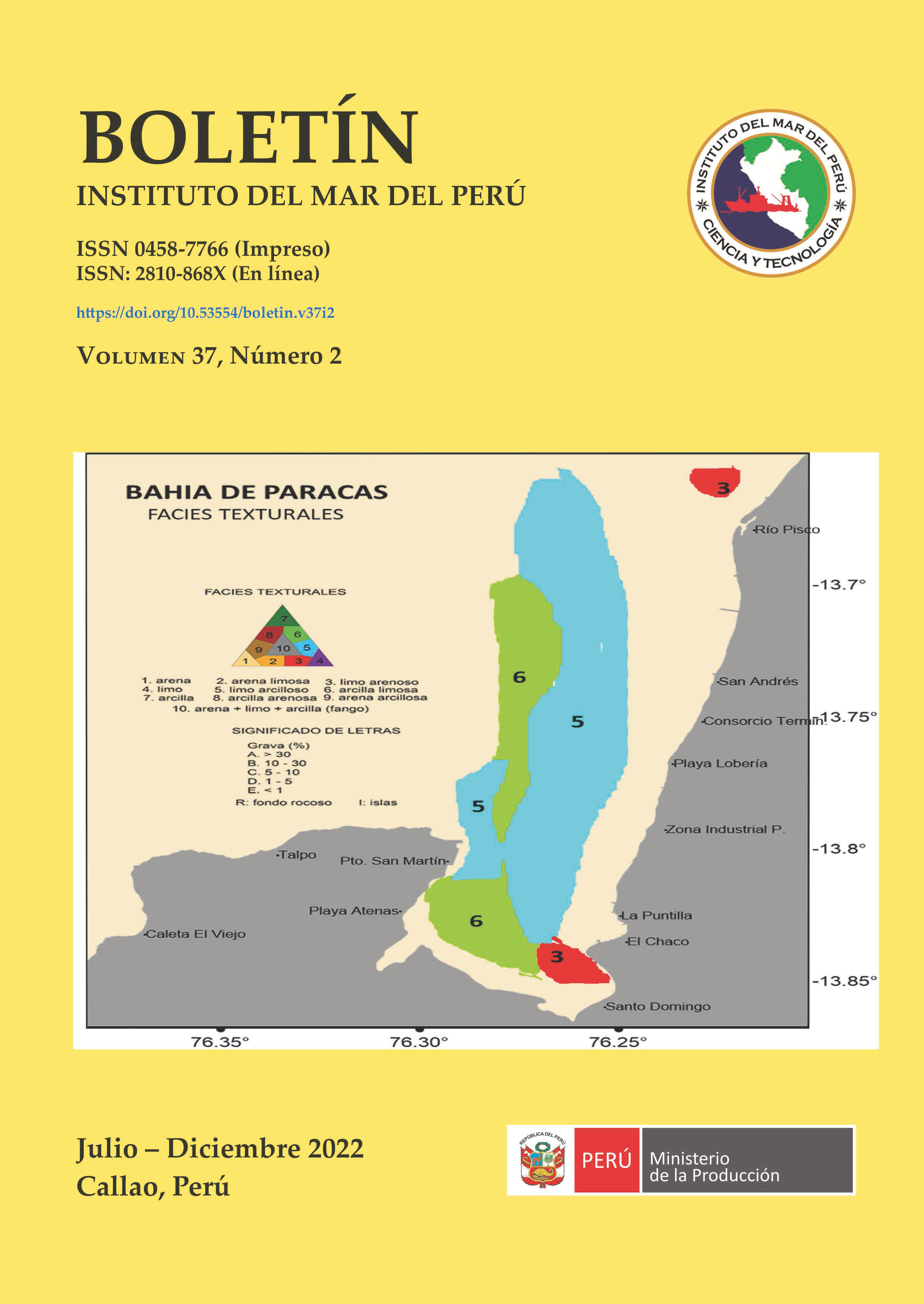Ichthyoplankton, euphausiids, and zooplankton biovolumes (summer-autumn 2015)
DOI:
https://doi.org/10.53554/boletin.v37i2.370Keywords:
Ictioplancton, Eufáusidos, Zooplancton, Engraulis ringens, AnchovetaAbstract
The 1502-04 hydroacoustic research cruise for pelagic resources was conducted between February 22 and March 31, 2015. 144 zooplankton samples were collected, using Hensen net of 300 μm mesh opening, in vertical trawls with the vessel stationary up to 50 m deep. A total of 18 euphausiid species belonging to the genera Euphausia, Nematoscelis, Nematobrachion, Nyctiphanes, and Stylocheiron were determined. The calyptopis and furcilia early stages predominated with frequencies of 68% and 87%, respectively. Likewise, 63 ichthyoplankton species distributed in 35 families were determined. Engraulis ringens was the most abundant species. Eggs and larvae ranged from 3 to 4,566 eggs/m2 and 3 to 2,574 larvae/m2 distributed from Talara to San Juan de Marcona. Vinciguerria lucetia eggs and larvae fluctuated from 3 to 4,212 eggs/m2 and 3 to 1,512 larvae/m2. They were distributed mainly outside the continental shelf, with eggs being found between Punta Sal and Pimentel, off Salaverry, and between Huarmey and San Juan de Marcona, while the larvae were located between Punta Sal and Punta La Negra, Pimentel and Salaverry, Huarmey and Independencia Bay, as well as off San Juan of Marcona, with densities greater than 500 larvae/100 m2 off Punta Sal, Talara, and Independencia Bay. In terms of frequency, other important Myctophidae species were Diogenichthys laternatus, Lampanyctus parvicauda, Triphoturus oculeus, and Myctophum nitidulum, which were recorded in 35%, 11%, 8%, and 6% of the total samples collected. Zooplankton biovolumes ranged from 0.001 to 5.72 mL/m3, with a median of 0.62 mL/m3. Values below 0.26 mL/m3 were the most frequent (47%) occurring from Paita to San Juan Marcona, mainly on the continental shelf. These values were located outside the continental shelf at 80 nm offshore between Punta La Negra and Salaverry.
Downloads
Alternative Metrics
Metrics
References
Aronés, K., Grados, D., Ayón, P., Bertrand, A. (2019). Spatio-temporal trends in zooplankton biomass in the northern Humboldt current system off Peru from 1961-2012. Deep Sea Research Part II: Topical Studies in Oceanography, 169, 104656.
Ayón, P., Purca, S., Guevara-Carrasco, R. (2004). Zooplankton volume trends off Peru between 1964 and 2001. ICES Journal of Marine Science, 61(4), 478-484.
Ayón, P., Swartzman, G., Espinoza, P., Bertrand, A. (2011). Long-term changes in zooplankton size distribution in the Peruvian Humboldt Current System: conditions favouring sardine or anchovy. Marine Ecology Progress Series, 422, 211-222.
Carrasco, S., Lozano, O. (1989). Seasonal and long-term variations of zooplankton volumes in the Peruvian Sea 1964 - 1987. In: Pauly, D., Muck, D., Mendo, J., Tsukayama, I. (Eds.), The Peruvian Upwelling Ecosystem: Dynamics and Interactions, pp. 82–85. ICLARM. 438 pp.
Einarsson, H., Rojas de Mendiola, B. (1963). Descripción de huevos y larvas de anchoveta peruana (Engraulis ringens J.). Bol Inst Invest Recurs Mar. Callao, I(1), 1-23.
García, W., Robles, C. (2000). Tempearatura y Salinidad del mar peruano durante la prospección del recurso
Vinciguerria lucetia, Crucero BIC José Olaya Balandra 9910. Inf Inst Mar Perú, 156, 48-52.
Harrington, S. A., Thomas, P. G. (1987). Observations on spawning Euphausia crystallorophias from waters
adjacent to ender by land (east Antarctica) and speculations on the early ontogenetic ecology of neritic euphausiids. Polar biology, 7(2), 93 - 95.
ENFEN. (2015). Informe técnico ENFEN. Estudio Nacional del Fenómeno El Niño.
Kramer, D., Kalin, M. J., Stevens, E. G., Thrailkill, J. R., Zweifel, J. R. (1972). Collecting and processing data on fish eggs and larvae in the California Current region. NOAA Technical Report NMFS, Circ-370. U. S. Department of Commerce. NOAA. National Marine Fisheries Service, Seattle, WA. 38 pp.
Moser, H. (1996). The Early Stages of Fishes in the California Current Region. California Cooperative Oceanic Fisheries Investigations. Atlas 33, 1505 pp.
Olivares, G. (2000). Mecanismos de interacción físico biológica en una zona de surgencia costera: retención de larvas y cierre de ciclo de vida de Euphausia mucronata. Tesis entregada a la Universidad de Chile en cumplimiento parcial de los requisitos para optar el grado de Magister en Ciencias Biológicas mención Ecología. Universidad de Chile.
Rojas de Mendiola, B., Gómez, O. (1981). Daily otolith rings in otoliths of larval anchovy (Engraulis ringens). Rapp. P.V. Reun. Cons. Int. Explor. Mer., 178, 565-566.
Santander, H., Sandoval de Castillo, O. (1973). Estudio sobre la primera etapa de vida de la anchoveta. Inf Inst Mar Perú, 4, 1-30.
Van Guelpen, L., Markle, D. F., Duggan, D. J. (1982). An evaluation of accuracy, precision and speed of several zooplankton-subsampling techniques. Journal du Conseil Conseil International pour L’exploration de la Mer, 40, 226-236.
Downloads
Published
How to Cite
Issue
Section
License
Copyright (c) 2022 Boletin Instituto del Mar del Perú

This work is licensed under a Creative Commons Attribution 4.0 International License.









